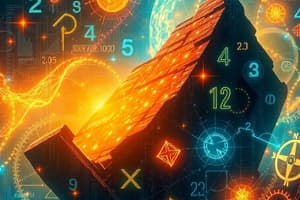Podcast
Questions and Answers
What does the domain of a function represent?
What does the domain of a function represent?
- The graphical representation of the function
- The relationship between angles and sides in triangles
- The set of all possible output values
- The set of all possible input values (correct)
Which of the following equations represents a linear function?
Which of the following equations represents a linear function?
- y = sin(x)
- y = 3x^2 + 4
- y = e^x
- y = 5x - 7 (correct)
What is the purpose of finding the derivative of a function?
What is the purpose of finding the derivative of a function?
- To describe the limits of a function
- To find the cumulative sum of a function
- To determine the instantaneous rate of change (correct)
- To measure the average value of a function
What characterizes prime numbers?
What characterizes prime numbers?
What does the Least Common Multiple (LCM) represent?
What does the Least Common Multiple (LCM) represent?
What is the result of the expression $5 - 3 + 2$?
What is the result of the expression $5 - 3 + 2$?
Which of the following is an example of a rational number?
Which of the following is an example of a rational number?
What does the mode of a dataset represent?
What does the mode of a dataset represent?
Which of the following best describes an equation?
Which of the following best describes an equation?
What is the perimeter of a rectangle with length 5 and width 3?
What is the perimeter of a rectangle with length 5 and width 3?
Which of the following statements about integers is true?
Which of the following statements about integers is true?
Which mathematical operation is represented by the expression $7 ÷ 1$?
Which mathematical operation is represented by the expression $7 ÷ 1$?
If $x + 5 = 12$, what is the value of $x$?
If $x + 5 = 12$, what is the value of $x$?
Flashcards
Domain
Domain
The set of all allowed input values for a function.
Range
Range
The set of all possible output values for a function.
Graphing Functions
Graphing Functions
A visual representation of a function's relationship using coordinates plotted on a graph.
Linear Functions
Linear Functions
Signup and view all the flashcards
Number Theory
Number Theory
Signup and view all the flashcards
Addition
Addition
Signup and view all the flashcards
Subtraction
Subtraction
Signup and view all the flashcards
Multiplication
Multiplication
Signup and view all the flashcards
Division
Division
Signup and view all the flashcards
Variables
Variables
Signup and view all the flashcards
Functions
Functions
Signup and view all the flashcards
Data Collection
Data Collection
Signup and view all the flashcards
Mode
Mode
Signup and view all the flashcards
Study Notes
Basic Arithmetic Operations
- Addition: Combining two or more numbers to find a total. For example, 2 + 3 = 5.
- Subtraction: Finding the difference between two numbers. For example, 5 - 2 = 3.
- Multiplication: Repeated addition of a number. For example, 2 x 3 = 6 (which is the same as 2 + 2 + 2).
- Division: Finding how many times one number goes into another. For example, 6 ÷ 2 = 3.
Number Systems
- Natural Numbers: Counting numbers (1, 2, 3,...).
- Whole Numbers: Natural numbers plus zero (0, 1, 2, 3,...).
- Integers: Whole numbers and their negative counterparts (...-3, -2, -1, 0, 1, 2, 3...).
- Rational Numbers: Numbers that can be expressed as a fraction p/q, where p and q are integers and q is not zero. Examples include 1/2, 3/4, -2/5.
- Irrational Numbers: Numbers that cannot be expressed as a fraction of two integers. Examples include π (pi) and the square root of 2.
- Real Numbers: The set of all rational and irrational numbers.
Algebra
- Variables: Symbols (like x or y) that represent unknown values.
- Expressions: Combinations of numbers and variables using arithmetic operations. Examples include 2x + 3, x² - 4y.
- Equations: Statements that show two expressions are equal. Examples include 2x + 3 = 7, x² - 4y = 0.
- Solving Equations: Finding the value of the variable that makes the equation true.
- Inequalities: Statements that compare two expressions using symbols like < (less than), > (greater than), ≤ (less than or equal to), ≥ (greater than or equal to).
Geometry
- Points: Basic locations in space.
- Lines: Straight paths extending infinitely in both directions.
- Angles: Formed by two rays sharing a common endpoint. Measured in degrees or radians.
- Shapes: Two-dimensional figures (like squares, triangles, circles) and three-dimensional objects (like cubes, spheres).
- Area: The measure of the space inside a two-dimensional shape.
- Perimeter: The total distance around the outside of a two-dimensional shape.
- Volume: The measure of the space occupied by a three-dimensional object.
Data Analysis
- Data Collection: Gathering information about a topic.
- Data Organization: Arranging data in a meaningful way (tables, charts).
- Data Interpretation: Drawing conclusions from the data.
- Mean (Average): The sum of the values divided by the total number of values
- Median: The middle value when values are sorted.
- Mode: The most frequent value.
Functions
- Functions: Relationships between variables, where one variable depends on another. For example, y = 2x.
- Domain: Set of possible input values for a function.
- Range: Set of possible output values for a function.
- Graphing Functions: Visual representation of the function's relationship using coordinates.
- Linear Functions: Straight-line graphs; represented by the equation y = mx + b.
Trigonometry
- Right-angled triangles: Relates angles and sides.
- Sine, Cosine, Tangent: Ratios of sides in a right-angled triangle with reference to an angle.
- Trigonometric Identities: Equations involving trigonometric functions that are true for all values of the angles.
Calculus
- Limits: Describing behavior of a function as input approaches a given value.
- Derivatives: Measures the instantaneous rate of change of a function.
- Integrals: Finds the accumulated change of a function over a given interval.
- Applications: Used to model and solve problems involving rates of change, area calculation, and optimization.
Number Theory
- Prime Numbers: Whole numbers greater than 1 that have only two divisors: 1 and themselves.
- Divisibility Rules: Rules to determine if a number is divisible by another.
- Greatest Common Factor (GCF): Largest number that divides two or more integers evenly.
- Least Common Multiple (LCM): Smallest positive integer that is a multiple of two or more integers.
Studying That Suits You
Use AI to generate personalized quizzes and flashcards to suit your learning preferences.




